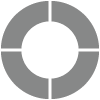Advanced Pivot Table Report
Like the Pivot Table, the Advanced Pivot Table Report is used to correlate responses to multiple questions based on how participants responded to a single question. This report is particularly useful if you would like to see your correlated questions in a clustered bar graph format, with responses compared across multiple groups. Additionally, the advanced version allows you to merge answer options to collect additional insights from your data.
This feature is available only in accounts on k12insight.com.
Generate Advanced Pivot Table Report
Follow these steps to create this report:
- Click on the All Projects icon and find your project. Hover over the project title and click on the Report icon.
- From the Report menu bar, click on the Pivot dropdown and choose Advanced Pivot Table.
- Choose whether to apply segmentation to your question. If you enable this option, questions that can be used for segmentation will be displayed and you can choose the right question and answer option(s) that should be used in generating this report. The selected question and answer options will be displayed as horizontal variables in your report. Note: If no possible segmentation questions are included, a message will be displayed to inform you.
- From Segmentation, click Continue to move on to select the questions that should be included in the report. A data table and graph will be generated for each question selected, with the answer options presented as horizontal variables and the selected segmentation question answer options presented as vertical variables. Make specific choices or select ‘All Questions’, then click Continue.
- Next, decide whether you’d like to merge any answer options in your report. If so, check the boxes in front of the options to be combined and click Merge below the question. Click Continue when you’re ready to move on.
- Select properties that you want to display in your report:
- Display Count: Displays the response count in your report
- Display Percentage:Lets you customize the number of decimals to be displayed for response percentage
- Exclude All ‘Did not Answer’is used to exclude the count of unanswered question from the number of total respondents for a question. Blank responses will not be displayed in the report.
- Include incomplete responses in the report is used to include partial responses that are yet to be submitted. Here, you can choose:
- All, to add all partially completed responses to the report
- Responses answered up to a specific question number
- Once you’ve reviewed and made any updates to the properties, click Continue to decide whether to apply a filter to your report to look at a specific slice of your data – for example, responses from new employees only. If you’d like to apply a filter, enable this option and select a filter from the dropdown list or by click on Create New to build a new filter.
- Finally, click Generate to create the report.
Any question type other than Ranking or open-ended options may be used for segmentation, and there is no limit on the number of answer options that may be included.
Review/Modify Advanced Pivot Table Report
To modify a generated report, click on ‘Modify this Report’ to be redirected to the first step of the report wizard.
Report Details
Survey Metrics: Survey Metrics displays Date, Invitation, and Responses Metrics, which provide details about the responses included in the generated report. You may click on the Edit icon beside the Survey Metrics option to show or hide particular Date, Invitation, and Response Metrics.
Properties and Filters: All report properties and response languages present in the generated report are visible here. You can edit, remove, or add the field which you want in the report by clicking on the Edit icon. If you are generating a report for a multilingual project, you may review responses submitted for particular language by selecting it from the language dropdown menu.
Commentary: Comments can be added in the report by clicking the ‘Add Commentary’ link.
Swap Rows and Columns: Quickly and easily rearrange your variables in your preferred display format.
Modify Graph Appearance: In addition to the data tables, data is displayed visually in Clustered Vertical Bar Graphs. These graphs can be modified by updating the chart type, 2D/3D display, and color scheme.
Subscribe for tips and insights to drive better decisions!












